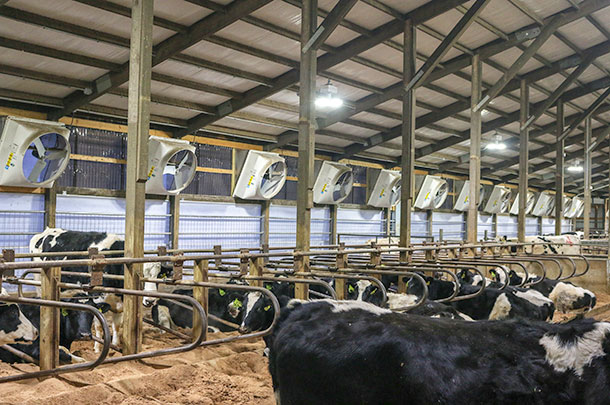“The newest freestall barn we’ve come up with is a combination hybrid barn: natural and positive ventilation,” says Gordie Jones, DVM, a partner in Central Sands Dairy in Wisconsin and a world-traveling dairy nutrition, facilities and cow comfort consultant. “It’s positively ventilated part of the year, naturally ventilated the rest.”
Jones is calling this concept the “all-seasons hybrid” barn because it easily adjusts to temperature fluctuation throughout the year. So far, in the first couple of barns that have been built or retrofitted with the design, that’s been achieved: On the coldest days of winter, manure does not freeze, and during the hot, humid days of summer, cows don’t bunch or exhibit signs of heat stress.

How it works
Jones worked with a northeast Wisconsin dairy family to implement the all-seasons hybrid prototype into both a new barn design and renovation of the farm’s existing buildings.
The nontraditional fan array, coupled with thermostatically controlled curtains, work in tandem to provide appropriate air exchange and direct cool air delivery precisely where it needs to be – at the cow level.
“It doesn’t matter where you are in the barn; every cow now has equally fresh air,” Jones says.
The arrangement includes 3-foot-diameter fans placed every 10 feet, running both lengths of a four-row freestall barn with 16-foot sidewalls. The ratio is one fan for every four stalls. Angled at 22 degrees, the fans blow onto the cows as they rest in head-to-head beds, and the air stream carries all the way to cool the backs of cows in the feed lane. No fans are placed over the feeding area.
“We are not blowing the soaking water onto the feed,” Jones adds.
When the temperature-humidity index (THI) is under the heat stress threshold, the design leverages the advantages of natural ventilation. The curtains are open and no fan power is needed. At 68 THI, the curtains automatically close and fans turn on to create positive ventilation, with an air exchange rate of 40 exchanges per hour at 70ºF, building up to 60 exchanges per hour by 80ºF.
When it dips below 10ºF, the exhaust is reduced down to four continuous air exchanges per hour, which is sufficient for successfully preventing manure from freezing in the barn. To enclose the barn, a curtain is lowered to cover the fans from the outside.
Looking up to the roof, an overshot ridge allows warm air to escape the barn, and a controllable vertical curtain prevents precipitation and snow from entering. High-velocity, low-speed fans placed every 80 feet mix air and bring it down.
The prototype barn has proven itself thus far by standing up to the weather extremes, from more than 20 days of zero or below temperatures last winter, to a peak of 100ºF last summer. Combined with other improvements like reducing overcrowding and widening out the main street to the milking parlor to 26 feet, the herd’s milk production increased from 80 to 85 pounds per day to topping at 108 pounds per day in just six months.
Jones credits this increase to a barn environment that encourages cows to do their job: “Stand to milk, stand to eat and drink, and lay down.” He adds, “Every extra hour in bed with a full rumen is now 5 pounds of milk.”

Not your grandpa’s barn
The all-seasons hybrid could mark the next generation of freestall barns. Over the years, the standard naturally ventilated barn with open curtains and fans over the beds and feed rails evolved to include mechanical ventilation means. However, Jones believes tunnel and cross ventilation have their shortcomings.
“The problem with both [tunnel and cross ventilation] is they are not delivering fresh air throughout the entire barn, and fans need to run 100 percent of the time,” he says. But that’s not the case in the all-seasons design.
“We need no power and no fans below 68 THI,” Jones states. “We don't need a generator. If it falls below 70 degrees, it becomes a naturally ventilated, open-curtain sidewall barn.”
Whether pulling air across the width of a cross-vent barn or pushing it the length of a tunnel-vent barn, there tends to be inconsistency in air delivery. It may not reach every cow in every stall, or the air may feel adequate in the feed lane, but stale at the cow level. Further, tasks such as feeding, bedding or removing manure may disrupt ventilation by interrupting the wind tunnel effect.
Jones believes the hybrid design does what the others cannot, and it’s versatile too.
“It’s a barn you can retrofit … or one you can build new,” he says, suggesting it can be a solution with various bedding types and in a robot design.
According to Jones, a handful of all-seasons hybrid barns are currently planned or under construction across the U.S. ![]()
Dr. Gordie Jones presented during the 2018 Vita Plus Dairy Summit, Dec. 4-6, in Red Wing, Minnesota.

-
Peggy Coffeen
- Editor
- Progressive Dairyman
- Email Peggy Coffeen
PHOTOS: Photos by Walt Cooley.






